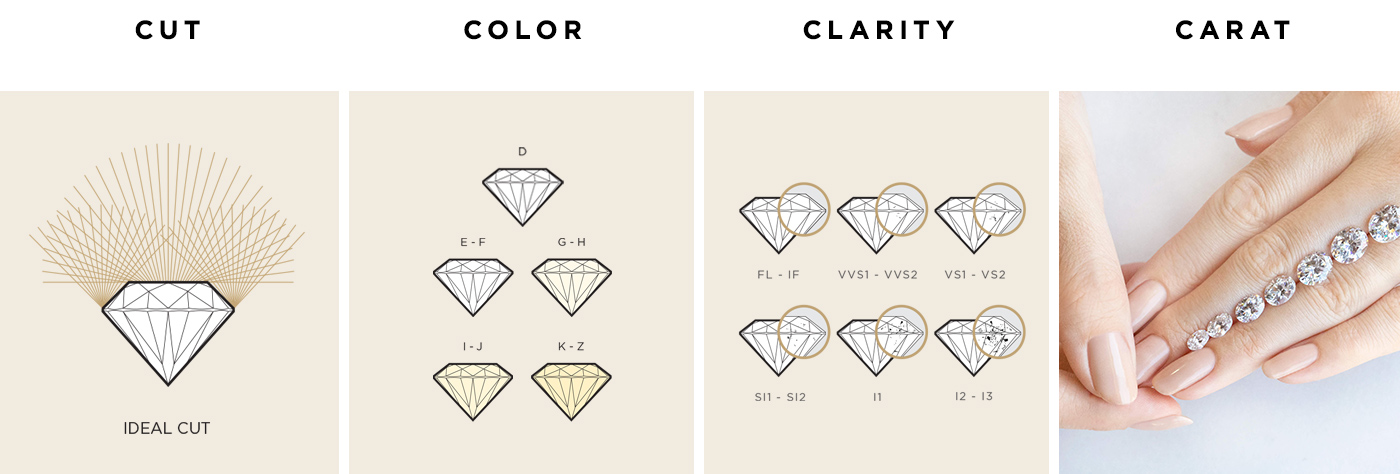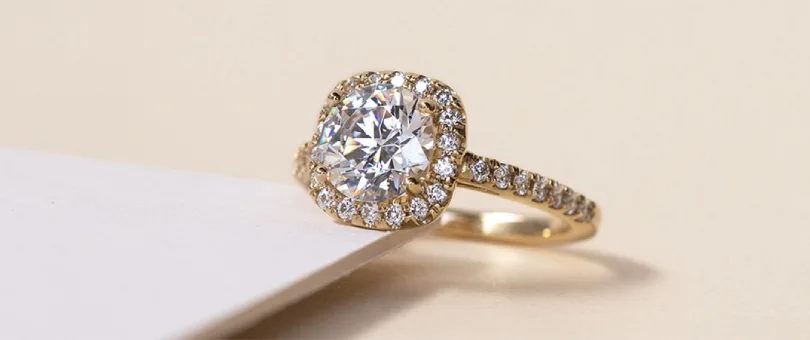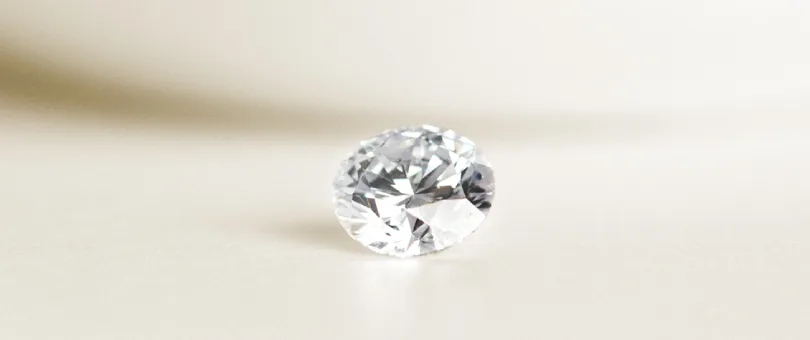Diamond Clarity Chart: A Comprehensive Guide for Savvy Buyers
January 22nd, 2014 / Alese Oldenburg
Shopping for a diamond, whether for your dream diamond engagement ring or a piece of simulated diamond jewelry, can be intimidating because of the many factors that go into the selection process. An easy key to help you determine the best diamond purchase is using the 4Cs of diamond grading. The 4Cs encompass the cut, color, clarity, and carat weight of the stone. Understanding how the diamond grading affects the quality will ensure you select the best stone that is also within your budget.
 Generally speaking, the better a stone is graded in each of these categories, the more rare and valuable it is. An internally flawless diamond would be at the top of any diamond clarity chart, however, these stones are incredibly rare and expensive. The diamond cut is considered the most important element, as it has the greatest impact on a diamond’s ability to shine and sparkle. Even the highest diamond quality will appear dull and lifeless if it is cut poorly. Next is the diamond color scale, with the rarest, flawless diamonds having absolutely no color or visible hues present. A diamond’s carat size is a measurement of the diamond carat weight and corresponding size. Finally, clarity is evaluated to identify any imperfections within the stone.
Generally speaking, the better a stone is graded in each of these categories, the more rare and valuable it is. An internally flawless diamond would be at the top of any diamond clarity chart, however, these stones are incredibly rare and expensive. The diamond cut is considered the most important element, as it has the greatest impact on a diamond’s ability to shine and sparkle. Even the highest diamond quality will appear dull and lifeless if it is cut poorly. Next is the diamond color scale, with the rarest, flawless diamonds having absolutely no color or visible hues present. A diamond’s carat size is a measurement of the diamond carat weight and corresponding size. Finally, clarity is evaluated to identify any imperfections within the stone.
Together, these four factors influence both the quality and value of a diamond – both natural mined diamonds and simulated lab grown diamonds. The impact of each will determine the price of a specific stone, but trade-offs can be made in order to stay within your budget and still find a beautiful diamond. As one of the four main factors, diamond clarity is key to understanding so you will have the expertise needed to find your perfect diamond or diamond alternative.
What is Diamond Clarity?
Simply put, diamond clarity grading is the assessment of any imperfections or noticeably visible inclusion on the surface or within a stone. A greater understanding of the clarity of diamonds can be found by answering the question, how are diamonds made?
Natural diamonds are formed of carbon deep within the earth that is subjected to tremendous heat and pressure, and through this process, some defects may develop. These defects include surface irregularities – known as blemishes – and internal flaws – known as diamond inclusion. Since most stones have microscopic blemishes and inclusions, undetectable to the naked eye, diamond clarity is the least important factor when purchasing a diamond. Therefore, clarity is truly the assessment of the relative absence of these defects.
Blemishes most commonly include scratches and nicks on a diamond’s surface. Inclusions, on the other hand, are slightly more complex. Though they are generally on the inside of a stone, in some cases they might break through the surface. Some inclusions are actually tiny diamonds or other mineral crystals that become trapped inside a diamond when it forms. Depending on their location, these clarity inclusions may linger in the stone after it has been cut and polished, thereby affecting its overall appearance. What makes a diamond sparkle can really be contingent upon how multiple different factors play together.
The Diamond Clarity Chart
The Gemological Institute of America (GIA) developed the now widely accepted standard for determining diamond clarity grade. The clarity scale consists of eleven unique clarity grades divided into six categories. Evaluating a diamond’s clarity requires a trained gemologist to determine the number, size, relief, nature, and position of any blemishes or inclusions and conclude how these affect the overall appearance of the individual stone. Again, no diamond is perfectly free from any imperfections, but many flaws are too small to be seen by anyone other than a trained diamond expert. Expert and accurate assessment of clarity are extremely important, since the closer a diamond comes to achieving perfection, the higher its value. Below are the six categories of the GIA diamond clarity chart.

-
Flawless (FL)
Achieving the coveted Flawless (FL) clarity grade is akin to discovering a diamond in the rough—a true rarity. Under the discerning gaze of a skilled grader employing 10x magnification, a Flawless diamond boasts an absence of visible inclusions or blemishes. This extraordinary level of perfection, found in less than 1% of all diamonds, elevates FL diamonds to a pinnacle of desirability, symbolizing the pinnacle of diamond clarity.
-
Internally Flawless (IF)
Internally Flawless (IF) diamonds, while not as elusive as their Flawless counterparts, still command admiration for their exceptional clarity. When scrutinized under 10x magnification, no visible inclusions mar the brilliance, though some minor blemishes may be observed. IF diamonds stand as a testament to the meticulous craftsmanship and quality that captivates the discerning eye.
-
Very, Very Slightly Included (VVS)
The Very, Very Slightly Included (VVS) category, further divided into VVS1 and VVS2, unveils diamonds with minuscule inclusions that challenge even the seasoned diamond connoisseur under 10x magnification. VVS diamonds epitomize subtlety, with VVS1 showcasing nearly imperceptible inclusions and VVS2 maintaining exceptional quality with slightly more visibility. Collectively, these grades underscore the remarkable clarity achieved through precision and expertise.
-
Very Slightly Included (VS)
Venturing into the Very Slightly Included (VS) realm, encompassing VS1 and VS2, introduces diamonds with minor inclusions, each varying in detectability under 10x magnification. While VS1 diamonds generally outshine their VS2 counterparts in clarity, both grades offer a harmonious balance between quality and affordability. VS diamonds emerge as popular choices, embodying a blend of clarity and economic sensibility for many diamond enthusiasts.
-
Slightly Included (SI)
Slightly Included (SI) diamonds, comprising SI1 and SI2, step into a realm of more noticeable inclusions, apparent to the skilled grader under 10x magnification. Notably, SI1 diamonds may reveal their inclusions even without magnification, showcasing a spectrum within this category. These diamonds strike a balance, providing a compromise between visual perfection and cost-effectiveness, appealing to those seeking both quality and value.
-
Included (I)
The Included (I) clarity grades—I1, I2, and I3—represent the final tier, housing diamonds with obvious inclusions. Skilled graders can easily identify these imperfections without magnification, and in certain cases, these inclusions may impact the diamond’s transparency and brilliance. While diamonds in this category may offer a more budget-friendly option, they also signify a compromise in terms of visual perfection, making them a practical choice for those prioritizing affordability.
Determining Diamond Clarity Grade
As mentioned previously, there are a number of elements that a trained and skilled gemologist considers in order to determine the clarity grade of a diamond. These factors mostly refer to the diamond inclusion and involve:
- Number: Most obviously, a higher quantity of present flaws will result in a lower clarity grade. This is examined as a total number of both inclusions and blemishes.
- Size: Larger inclusions or blemishes will also have a greater impact on a diamond’s clarity than more minute ones. This is due to the fact that a bigger flaw is likely more noticeable without magnification or skilled training.
- Relief: This refers to the visibility of an inclusion in contrast to the diamond itself. A higher relief will appear darker in color against the rest of the stone, resulting in a lower grade.
- Nature: This factor regards the type of inclusion that is present in relation to the depth or other characteristics of the diamond itself. Any flaw situated on the diamond’s surface that has not penetrated the interior is referred to as a blemish, not an inclusion. While blemishes are not desirable themselves, inclusions are the more problematic flaw in clarity grading.
- Position: Where the inclusion is located on a diamond is critical in determining its clarity. An inclusion that is close to the center of the stone’s table, or the flat top surface, will have a stronger negative impact on the stone’s clarity than an inclusion closer to the girdle, the widest rim of the stone. This is because an inclusion near the center of the table will be more visible. Similarly, inclusions found near the pavilions of the diamond, the facets which slope down, can reflect. The facets act as mirrors, which can make imperfections in this location difficult to see.
All of these factors are considered in order to determine the clarity grade of a diamond. However, certain flaws can be obscured or emphasized by the shape, proportions, and facet arrangement of the diamond. So, a poor clarity rating is not the end-all-be-all for every diamond.
Diamond Alternatives on the Clarity Scale
There is a multitude of different diamond options aside from natural, mined diamonds in today’s market, giving consumers more alternatives to consider than ever before. Having an understanding of the clarity diamond grading of lab grown diamonds and diamond alternatives can be helpful in assessing various diamond options and answering the question, are lab diamonds real?
Lab grown diamonds are composed of carbon, similar to a natural diamond, and therefore are subject to the same types of flaws and inclusions. These are measured on the same GIA diamond clarity scale. Another option, Moissanite, is not consistently graded on its clarity characteristic, so will be a bit harder to measure in terms of price and quality.

Nexus Diamond™ alternatives are lab created diamond alternatives that are crafted specifically to have IF-rated clarity. The patented chemical formula used to create the diamond alternative imitates the look, weight, and feel of a traditionally mined diamond, but can be manipulated to create flawless simulant stones that are of the highest grading on every scale. With Nexus Diamond alternatives, you can ensure a perfect stone, but at a much more affordable price and with an ethical & environmentally friendly guarantee.
What is the Best Diamond Clarity?
All Natural Diamonds have Imperfections
When considering the clarity characteristic, it’s important to remember that all natural diamonds contain imperfections. They are created under extreme pressure and mined from the earth, which is a far from perfect process. If you are considering a natural diamond purchase, do not feel like you should only be looking at FL or IF diamonds. In fact, when it comes to natural diamonds, the best value is found in a stone that has inclusions that cannot be seen with the naked eye or through the top of the stone without magnification, more commonly known as an eye-clean diamond. These include stones with clarity diamond grading as low as VS or even SI and come at a much more affordable price than diamonds with higher grades.

Shape and Size can Impact Clarity
It is also important to understand that a diamond’s shape and size will impact a diamond’s clarity. Be sure to do a carat size comparison because as a diamond’s size increases, so too do the size of its facets that can act as windows to the interior of the stone. If facets are bigger, this has the potential to make inclusions easier to see. Similarly, any diamond shape that has larger facets, such as emerald or Asscher, emphasizes the transparency of a diamond. This allows you to see deeper into the interior, which can make inclusions more visible. Alternatively, round, princess, oval, marquise, and pear shapes have intricate facet patterns that reflect light from many angles which, in turn, can naturally hide inclusions.
Why Choose a Diamond Alternative?
A notable alternative to natural diamonds, especially when it comes to clarity, is a diamond alternative. There is a wealth of options available to you, from lab-grown to Nexus Diamond alternatives. While most of these will be generally more affordable than natural diamonds, where they can really stand out is on the diamond clarity scale. Empowered with the knowledge of the clarity scale and how it affects diamond quality, you are poised to find the diamond of your dreams, for any of your jewelry needs!
*Diamond Nexus strives to provide valuable information while being clear and honest about our products. The Nexus Diamond™ alternative is a patented lab-grown stone that, among all simulants, most closely imitates the look, weight, and wear of a mined diamond, with two exceptions – it is absolutely perfect in every way, and it costs significantly less. Price points and environmental facts expressed in this blog were taken from popular online retailers and may vary. Learn more about the environmental impact of mining by visiting our blog.

